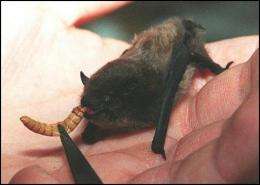Batphone: From baddies to biodiversity

Scientists have brought to life the batphone, launching a new smartphone app to monitor the world's bats.
From Transylvania to Tooting, citizen scientists will be pointing their smartphones to the skies to capture the ultrasonic calls of bats in their local area.
The iBats app has been developed for both the iPhone and Android phones by the Zoological Society of London (ZSL) in conjunction with the Bat Conservation Trust, Dr. George Roussos of Birkbeck, University of London, and Dr. Adam Talcott of Atomic Powered, USA.
The iBats app will assist a global network of more than 700 volunteer bat-trackers who are part of a global bat monitoring programme called iBats funded by The Darwin Initiative and The Leverhulme Trust.s
The handheld technology lightens the load for volunteers who previously had to carry three pieces of recording kit to monitor their local bat species. With the launch of the iBats app, they now only need their smartphone and an ultrasonic microphone.
iBats volunteers are currently recording bat calls in the UK, Eastern Europe, Ukraine, Russia and Japan. The scientists coordinating iBats hope the launch of the iBats app will encourage more people to get involved in the project.
"Bats are like a heart monitor for wildlife. Their presence can tell us a lot about the health of the environment because they have an important role in terms of eating insects and acting as pollinators for many different plant species.
"We hope the iBats app will encourage more people to monitor their local bats and make a contribution to the global conservation of wildlife," says Dr. Kate Jones, iBats Project Manager from ZSL.
The iBats app is capable of recording the calls of more than 900 species of bats which use echolocation for finding food and navigation. Volunteers will be able to upload recorded calls to the iBats website which uses special software to identify the bats that have been recorded.
Environment Minister Richard Benyon said: "This innovative new app helps people connect with nature as never before and will make a real difference to global conservation efforts.
"I'm pleased that Defra is able to support this scheme through its Darwin Initiative. We're boosting funding by £25 million over the next four years, meaning better protection for wildlife in parts of the world where it's most at risk."
The information collected by the iBats program has advanced scientists' understanding of the different species of bats that populate our skies and the status of their populations. The detailed soundscapes enable scientists to differentiate between bats and identify new species.
ZSL and the Bat Conservation Trust are now looking for further technical investment in the iBats app to integrate the microphone into the phones, so that everyone with a smartphone will be able to identify bats at the touch of a button.
Provided by Zoological Society of London

















